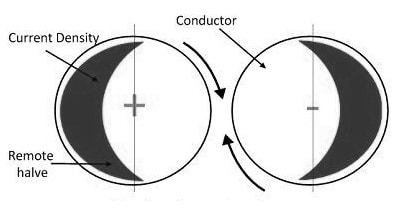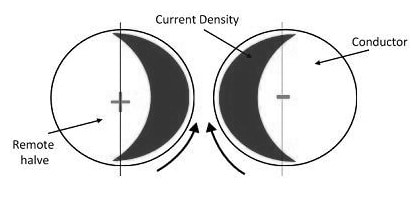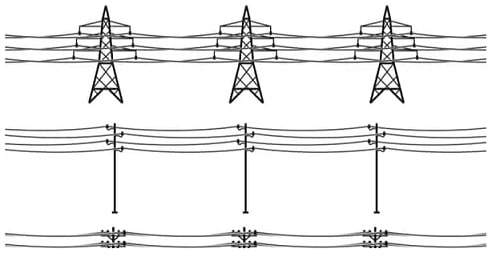Understanding & mitigating the proximity effect is significant in the electrical system design & operation which uses high-frequency AC. The strength of this effect can be influenced by the conductor’s structure, diameter & material. The impact of this effect can be reduced by right conductor spacing and geometric arrangement and also decrease power loss, its detrimental effects on resistance & performance of inductor. It is achievable to decrease the effect by decreasing the conductor size & the frequency by enhancing the space & voltage in between conductors. This article discusses an overview of the proximity effect, working, and its applications.
What is the Proximity Effect?
The proximity effect can be defined as; an electromagnetic phenomenon where the non-uniform flow of AC within multi-turn windings (or) nearby conductors can lead to a significant rise in power loss when compared to direct current. The extra power loss which is caused by this effect is known as proximity loss.
Proximity Effect in Conductors
The proximity effect in conductors is; that whenever two conductors carry high alternating voltage then the currents will be distributed non-uniformly on the conductor’s cross-section area. This effect will result in the growth of the apparent resistance for the conductor because of the occurrence of the other conductors that carry current in its surrounding area.
Whenever a minimum of two or above conductors are located close to each other, their electromagnetic fields will interact through each other. Because of this interaction, the flow of current within every conductor is redistributed so that the concentrated current density is greater.
If the two conductors carry the current in a similar direction, then the magnetic field of the conductor’s halves is very close to each other. Thus, there is no flow of current throughout that halves part of the conductor. So the current is packed within the remote half section of the conductor.

Current in the Same Direction
Whenever the two conductors carry the current within the reverse direction, the close element of the conductor carries more current & the magnetic field of the far-off half of the conductor will cancel each other. Therefore, the current is zero within the remote half of the conductor & packed at the closer element of the conductor.

Current Flow in Reverse Direction
If DC supplies on the conductor’s surface, then the flow of currents is distributed uniformly around the side view area of the conductor. Therefore, no proximity effect happens on the conductor’s surface. This effect is only significant for conductor sizes > 125 mm^2. The proximity effect formula is;
Re = Rdc (1+ydc +yp)
Rdc is not corrected DC range of the core
yp is the proximity effect factor.
Re is the corrected or effective ohmic resistance for the core.
The Rdc is a resistance.
Proximity Effect on Transmission Lines
Conductors that carry AC will generate alternating flux within nearby conductors. So this alternating flux causes a flowing current within the conductor to create a distribution of non-uniform current within the transmission line by improving the apparent resistance of the conductor. So the increased resistance with the transmission line can cause a voltage drop as well as power loss which is known as the proximity effect.
How does the Proximity Effect impact Transmission Lines?
The current flow concentration throughout nearby conductors changes with the alternating magnetic field & also its related eddy currents. Once the conductors carry current in a similar direction, then the flow of current throughout them gets concentrated at the utmost side of the conductor. Similarly, when current flow throughout adjacent conductors is in the reverse direction, then the flow of current gets concentrated within the nearby face of both conductors.

Proximity Effect in Transmission Lines
When the AC frequency is enhanced, the effect will become stronger. Conductors that carry 50Hz of current bear less proximity effect as compared to conductors that carry 60Hz of current.
As compared to 50Hz transmission lines, 60Hz transmission lines have higher effective resistance & power loss. All over the world, most countries utilize 50Hz AC frequency. The 60Hz frequency within the transmission line can cause more proximity effects as compared to the 50Hz.
The effect in DC transmission is an impossible phenomenon because of changing magnetic fields. When DC frequency is nothing, then it will fail to generate an alternating magnetic field within nearby conductors. So the current concentration will remain consistent within DC transmission lines, excluding the skin effect influence.
Affecting Factors
Several factors that affect the proximity effect are the material of the conductor, diameter, structure, and frequency which are discussed below.
Material of Conductor
If the conductor’s material is made with high ferromagnetic material then this effect will be high on their surface.
Frequency
This effect will increase by increasing the frequency.
Diameter
This effect will increase with the increase within the conductor.
Structure
This effect is high on the solid conductor when compared to the stranded ACSR conductor because this conductor’s surface area is lesser as compared to the solid conductor.
How to Reduce Proximity Effect?
Many factors that can reduce the proximity effect are discussed below.
The proximity effect is proportional directly to the outside area of the conductor. Thus, when the surface area of the conductor is enhanced, then this effect will become much stronger. Changing solid conductors by replacing them with stranded conductors will help reduce the surface area of the conductor and reduce the effect.
Dummy conductors can assist in increasing the conductor’s space. But, this will come at an additional cost within support structures.
Transmitting power continually throughout transmission lines can increase voltage and decrease current. The decreased size of conductors can reduce the effect. Even though, decreasing the transmission voltage & current frequency can also reduce the effect.
This effect can be decreased with the ACSR conductor. So the steel in this type of conductor is located in the middle of the conductor & the aluminum conductor is arranged around a steel wire. The steel improves the conductor’s strength although reduces the surface region of the conductor. Therefore, the flow of current will be mostly in the external conductor layer & there is no current carried within the conductor, so reduces the proximity effect.
Difference between the Proximity Effect and Skin Effect
Both the proximity and skin effect are two phenomena that mainly occur within electrical conductors, especially in high-frequency (or) AC systems. These two effects impact the current supply in a conductor, so it leads to non-uniform current flow. The difference between the proximity effect and skin effect includes the following.
Proximity Effect | Skin Effect |
| The proximity effect is an occurrence where the current distribution within a conductor can be affected by the existence of adjacent conductors that carry current. | Skin effect is the tendency of AC to focus near the face of a conductor in place of being equally distributed across the whole cross-section. |
| Whenever several AC-carrying conductors are located close to each other, then their magnetic fields can interact. So this can cause the current flow within every conductor to be reallocated, with an inclination for the current to focus on the face of the conductor facing away from the adjacent conductor. | This effect mainly occurs because, at high frequencies, the varying magnetic field produced by the current makes eddy currents in the conductor. So these currents can make their magnetic fields, which resist the original current. Consequently, the current’s higher-frequency components tend to supply very close to the face wherever they experience low resistance. |
| This effect leads to irregular current distribution & an increase in efficient resistance. At high frequencies, it will become more significant & whenever the spacing between two conductors is decreased. | The conductor’s effective resistance enhances for higher-frequency components which leads to enhanced power losses. So this means that when the AC frequency rises, more current is supplied near the conductor’s surface which decreases the available efficient cross-sectional region for the flow of current. |
| Many factors affect the proximity effect mainly including; the diameter, structure & material of the conductor. | Many factors effect skin effect mainly including; temperature, diameter of conductor, line frequency, and conductor shape. |
Advantages and Disadvantages
The advantages of the proximity effect include the following.
- This effect increases adjacent conductors’ AC resistance as compared to its resistance to a DC.
- This effect can be applied to all sound sources.
- Generally, this effect involves spatially separated normal & superconducting subsystems
The disadvantages of the proximity effect include the following.
- This effect is not significant in transmission lines because of more space between the conductors while the space between cables is low.
- This can affect both the temporal & spatial fabrication process domains.
- It occurs within high AC voltage transmission lines.
- This effect happens within two (or) more overhead conductors because of flux linkages.
- The proximity effect in DC is not possible due to changing magnetic fields.
Applications
The applications of the proximity effect include the following.
- This effect is significant wherever there is some magnetic field like permanent-magnet DC motors due to ripples within the field penetrating the DC windings.
- This is a limitation within AC power transmission caused by an increase in the apparent resistance of the conductor.
- This effect is effectively used to cut feedback within a sound reinforcement condition.
- This effect is used in audio to increase the bass (or) low-frequency response whenever a sound source is very close to a cardioid or directional microphone.
- This effect in electromagnetics is a relocation of electric current in near parallel electrical conductors that carries AC caused by magnetic effects.
- It can also be utilized to enhance the drum’s sound.
What causes the proximity effect?
- This effect can cause the overall current-carrying capacity can be decreased.
- The AC resistance can be improved
- The induced Eddy current can cause losses in this system.
What is the importance of the proximity effect?
It can increase the AC resistance greatly & the copper losses within the transformer.
What frequency is the proximity effect?
This effect is noticeable on sounds with low below 200 Hz low frequency.
Thus, this is an overview of the proximity effect, working, differences, advantages, disadvantages, and applications. In a conductor, an increase within apparent resistance can cause a voltage drop as well as power loss, so this phenomenon is known as the proximity effect. It is achievable to decrease the effect by decreasing the conductor size & the frequency by enhancing the space & voltage between two conductors. Here is a question for you, what is the skin effect?